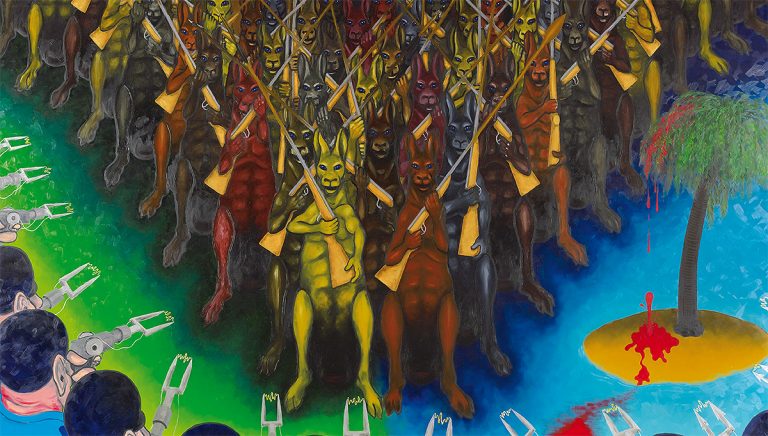We acknowledge the Traditional Owners of the land on which the Queensland Art Gallery | Gallery of Modern Art stands and recognise the creative contribution First Australians make to the art and culture of this country.

Gordon Hookey / Waanyi people / Australia b.1961 / Blood on the wattle, blood on the palm 2009 / Oil on linen / 285 x 500cm / The James C. Sourris AM Collection. Gift of James C. Sourris AM through the Queensland Art Gallery Foundation 2012. Donated through the Australian Government’s Cultural Gifts Program / Collection: Queensland Art Gallery | Gallery of Modern Art / © Gordon Hookey/Copyright Agency
Gordon HookeyBlood on the wattle, blood on the palm 2009
Not Currently on Display
Blood on the wattle, blood on the palm 2009 by Gordon Hookey is a powerful example of resistance art. Created in response to the 2004 death in custody on Palm Island — and the ensuing unrest and violence — Hookey’s trademark kangaroos stand armed with gun–spears, defiant in the face of riot police.
The title refers to the Bruce Elder book, published in 1988, Blood on the Wattle: Massacres and Maltreatment of Aboriginal Australians Since 1788, about frontier violence against Aboriginal people.
‘Blood on the wattle’ also references the poem by Henry Lawson, written during the 1891 strike in Barcaldine, when some 1400 shearers demanded rights and improved conditions for workers.
Gordon Hookey was born in 1961 in Cloncurry in north-west Queensland; he now lives and works in Brisbane. Hookey has exhibited in several solo exhibitions and numerous group exhibitions around Australia, and his works are held in private and public collections in Australia and overseas.
Hookey has purposefully adopted a Western style of figurative painting for his satirical art, which is based on social commentary. His paintings and sculptures are inspired by history and everyday life, and often include images of native Australian animals representing Indigenous Australians; the kangaroo is a particular favourite.
In 2000 Hookey explained his position as artist and activist: “My art-making is located at the interface where Aboriginal and non-Aboriginal cultures converge. A lot of concerns and issues still have to be addressed. There is no real accountability for the injustices committed in relation to Aboriginal rights. Aboriginal rights are the last things to be considered when it comes to mammonic regimes and multinational investments on our land. The Australian Government is still under England’s influence, and it embraces capitalist imperialist ideologies of the United States of America. Australia is not a country or a federation: it’s a multinational corporation… My art comes from the passion I feel for my country and my people. Sadly, it also reflects my frustration with the spiritless, small-minded people that ultimately hold power over our lands and our lives.”1
Endnotes:
2. Gordon Hookey quoted in Smith, Trevor. ‘Gordon Hookey’, in ‘Beyond the pale: Contemporary Indigenous art: 2000 Adelaide Biennial of Australian Art’. Art Gallery of South Australia, Adelaide, 2000, p.34.
Discussion Questions
1. Can you identify how Gordon Hookey uses metaphors in this work? How does a metaphor make a message more powerful?
2. Why does Hookey refer to two plant species in the title and why has he split his background into two halves of green and blue?
3. Research other works by Gordon Hookey. How does he employ the motif of the kangaroo in his art?
Activities
Design a poster that combines a play on words with a animal that symbolises the message of your protest.